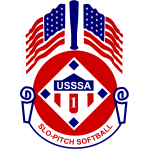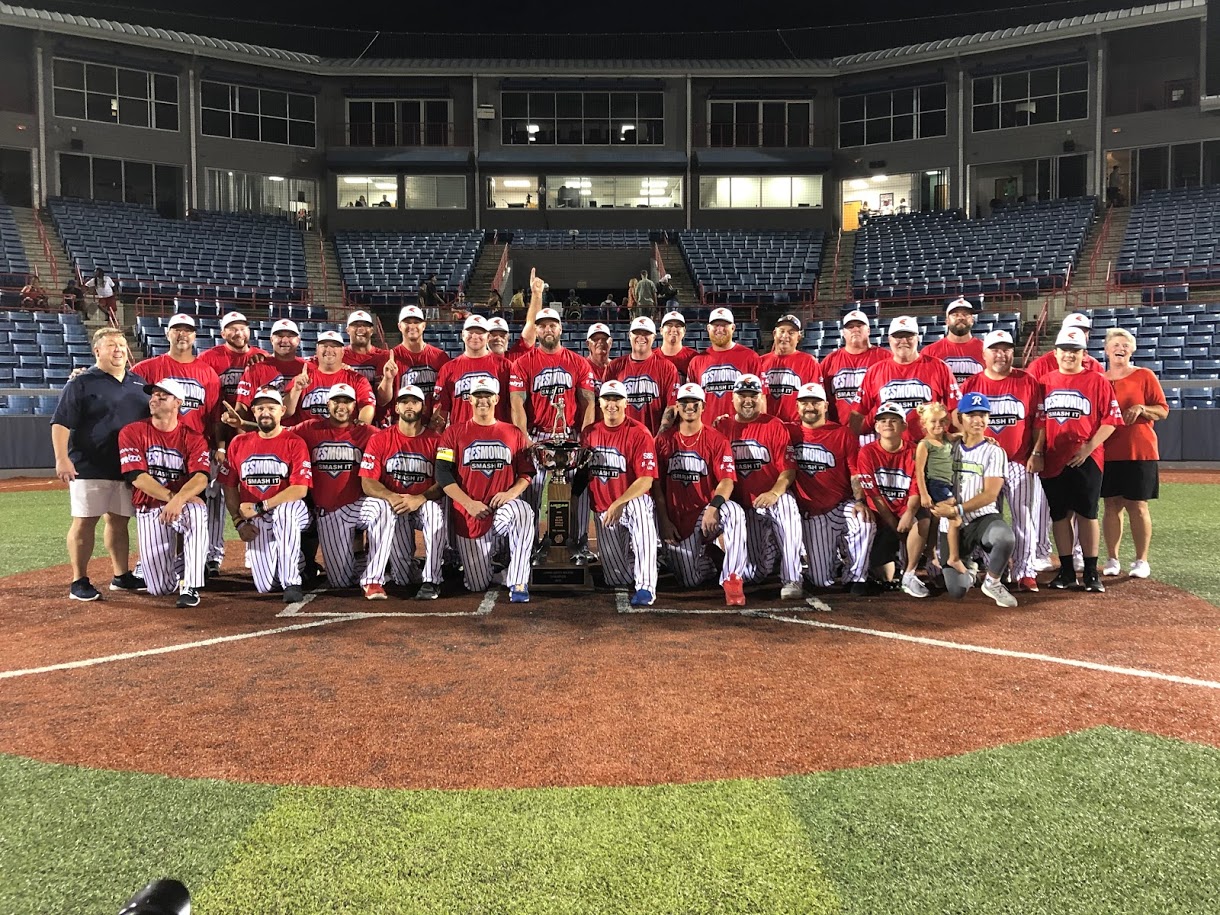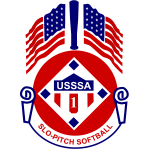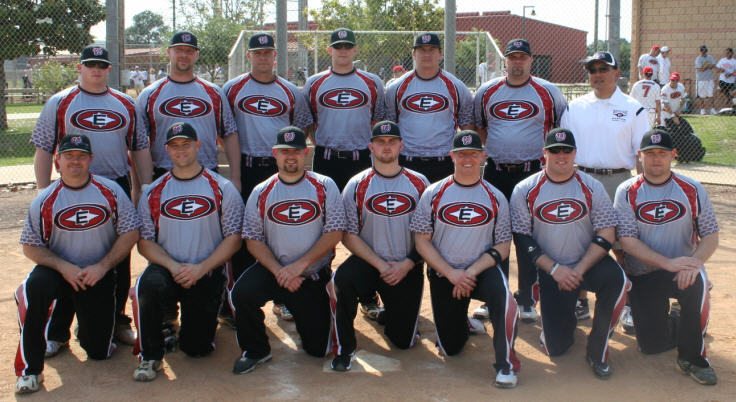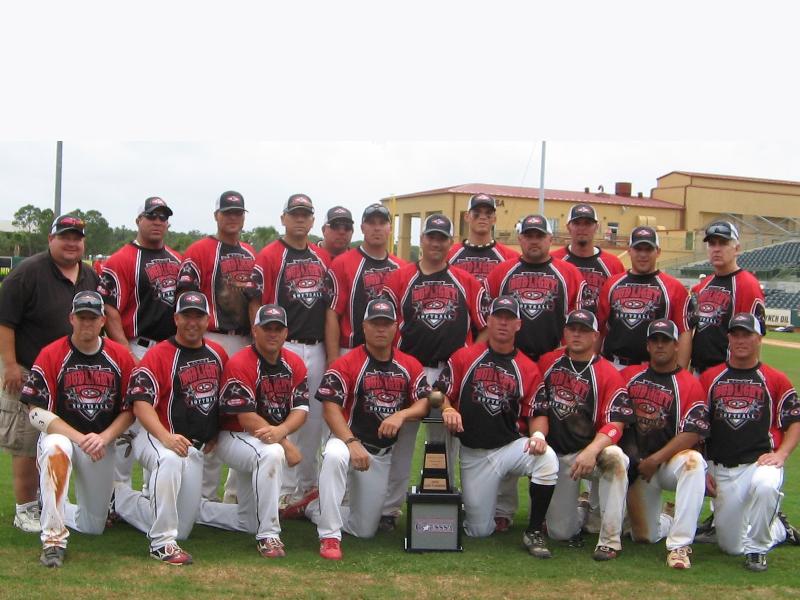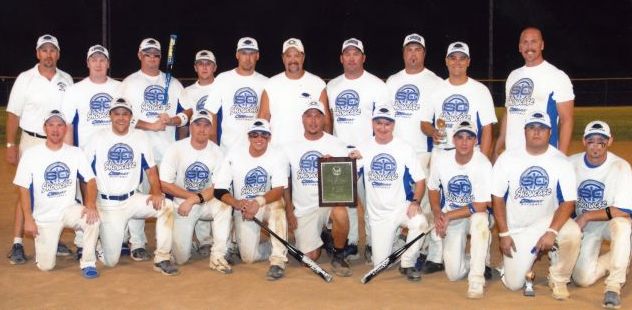It all began in a motel room in Pittsburgh, PA, in 1968 when a group of disenchanted slow pitch managers of past National championship teams and directors met to find an answer to advancing and updating the popular game of slow pitch softball.
They had just returned from the National Commissioners Meeting of the only major softball association in the country where most of their ideas and suggestions had been turned down. Their main concerns were longer fences, 65-foot base paths, smaller batter’s box, more media coverage and financial support for the slow pitch program. They recognized slow pitch was being played by the overwhelming majority, but the game was taking a back seat to fast pitch.
These pioneers decided to take a daring step and hold an experimental world tournament at the close of the 1968 season and play under the banner of a newly formed association. Several more meetings resulted in the birth of the United States Slo-Pitch Softball Association.
USSSA was chartered that year in Wisconsin. The first officers were Robert J. Mueller of New Berlin, WI, as President: James DiOrio of Pittsburgh, PA as Vice-President; Ray C. Ernst of Hebron, KY, as Executive Coordinator; Frank Ciaccia of Rochester, NY as Treasurer; and Ted Mazza of New Berlin, WI as General Counsel.
One of the first steps was to prepare a constitution and rule book. After several months, those tasks were completed. The hard and dedicated work of Ray Ernst in preparing the original USSSA Rule Book will always be remembered. It was the first separate rule book for slow pitch softball ever published.
Although many rule changes have been made over the years, the original 65-foot base path was the key. From the start, the USSSA playing rules were identified with 65-foot base paths and 300-foot fences. USSSA has always been respected for making changes to improve slow pitch.
The response to the experimental world tournament was astounding. Fifty teams from 15 different states entered the event. Several teams were former ASA National Champions. The tournament was won by Mueller Pipe Liners of New Berlin, WI. The Brookline Club of Pittsburgh was second and Jim’s Sport Shop of Pittsburgh finished third.
One of the important factors that gave USSSA pioneers hope and faith to pursue was the courage and fortitude of those 50 teams to step forward and play in the first event. There is no doubt, that if the 1968 tournament had failed, the USSSA would never have gotten off the ground.
By the beginning of the 1969 season, 41 District Directors had been appointed. The next three years were the hardest and most trying in the young life of the organization. Many call it a miracle, but somehow the USSSA was able to survive every setback and refused to go down for the count. From 1969 through the 1971 season, the USSSA was led by President Mueller. His shrewd ability to stay one jump ahead of rivals, who did not want to see USSSA survive, was amazing.
Old timers often look back and reminisce about early USSSA National Meetings during those lean years, with only eight people in a motel room for a day. Now, over 500 persons annually attend the National Meeting. Financial problems plagued the Association at the start and many of the early USSSA pioneers personally contributed much financial support. Substantial help also came from softball and sporting goods manufacturers. Through their support, USSSA started to grow. The manufacturers could see the future potential of the USSSA.
By the end of the 1971 season, however, USSSA was struggling to make ends meet. In debt and with directors resigning, the Association reached a climatic point of whether to continue. Mueller advised the Association that he could no longer serve as Chief Officer.
Needless to say, the Executive Board had its work cut out when it met in November of 1971 in Petersburg, VA. This meeting will always hold a place in USSSA history. After careful review, the decision was made to continue and the Executive Board elected Al Ramsey, a 40-year old Petersburg native, as National President. Ramsey’s long-time friend Jerry Ellis was elected to serve as both Treasurer and Secretary.
Ramsey had previously served with USSSA as Regional Vice-President and State Director for Virginia. Regarded as one of the most effective organizers in the country, he brought a refreshing look as President. Ramsey went to work immediately, locking the Executive Board behind closed doors for the next two days. The constitution was completely overhauled and Ramsey instructed the Board to pledge itself to operating on a sound business basis and launch an all-out campaign for new qualified personnel.
The USSSA prospered from hard work and determination shown on that history-making weekend. They made decisions that turned the USSSA around and headed it in the right direction.
Board members who took part at that eventful meeting, included Ramsey, Ellis, Ciaccia who was elected Eastern Division Executive Vice-President, Betty Minter of Louisville, KY, elected National Women’s Coordinator; Floyd Salter of Rochester, NY, elected National Umpire-In-Chief. Also attending were veteran USSSA Regional Vice-Presidents Ed Williams of Louisville, KY, Gary Wallick of Arcadia, CA, and Tony Gaetano of Pittsburgh, PA.
USSSA National Headquarters was immediately moved to Petersburg, VA, where it remains today. The Association was incorporated in the state of Virginia as a non-profit organization.
In 1972 things started to happen. Over 30 Directors were replaced and 60 new Directors were appointed. In less than a year, the Association was completely out of debt and operating on a sound financial basis. Team and umpire registrations began to show considerable increases.
The 1972 National Meeting was held in Rochester, NY, and some 75 directors attended. It marked the first USSSA National Meeting with a true convention atmosphere.
USSSA expanded the Church Program in 1973 and held its first World Church Tournament in York, PA.
Prior to 1974, USSSA operated by separating teams into two Divisions, the Eastern and Western. But in 1974, the Central Division was formed and the Association expanded the Men’s Program to include an eight-team World Series.
The year 1975 saw the Women’s Program expand to include Class B and the Men’s Program added a Class C classification. A National Invitational Tournament Program was added for Class A teams.
By 1975 USSSA was growing by leaps and bounds, although many teams and players were being threatened with suspension or disbarment by the Amateur Softball Association for playing in the USSSA Program. The USSSA filed suit against the ASA in Federal Court in Nashville, TN, to stop the threats to teams and players. In December of 1975, USSSA and the ASA signed an agreement to allow teams of both organizations to engage in the play of amateur softball in an article of alliance between the two organizations.
The alliance was dissolved in January of 1976 after ASA amended its bylaws to allow teams to participate in non-ASA sanctioned tournaments without penalty or suspension.
But in 1977, USSSA was forced to reopen the lawsuit against the ASA to stop actions by some ASA Commissioners who refused to abide by the settlement agreement. On January 18, 1978, the Federal Court ruled in favor of the USSSA. The court order wrote the final chapter in a long legal battle fought by the USSSA to give teams the right to play anytime and anywhere without being penalized. The court ruling was a total victory for the USSSA and slow pitch softball teams.
The City of Petersburg sent a delegation to the 1976 USSSA National Meeting and offered to donate two acres of land to construct a National Headquarters and Hall of Fame Building. The Association accepted the donation and voted to permanently locate its National Headquarters and Hall of Fame Building in the city.
The 1978 season saw the birth of the Youth Program which has grown steadily ever since. Also, the Association launched an all out Hall of Fame Building Fund Drive. Various USSSA State Associations continue today to take part in conducting programs to contribute to the USSSA Hall of Fame Foundation. At the National Meeting in 1978, the Association elected its first members into the Hall of Fame.
In 1979, the 11-inch softball was adopted for the Women’s and Youth Programs in a dramatic move. It instantly proved to be one of the greatest changes ever made for Women and Youth.
The 1980 season proved to be a banner year for team and umpire registrations. The Southern Division was also born, the Mixed Program was launched, and the Association hired Ramsey as its Executive Director. He had served eight consecutive years as National President. Frank Ciaccia became the Association’s third President.
In 1981, USSSA purchased a 24,000-square foot building in Petersburg for its National Headquarters and Hall of Fame Museum. The support of the fund raising campaigns throughout the entire Association made the purchase a reality.
The year 1981 also saw the all-important Midwestern Division formed, the final link in bringing the USSSA Program to every state. Also, a Divisional meeting concept was introduced and the Masters “Old timers” Program was added.
In 1982, Jerry Ellis was elected the Association’s fourth National President. By the end of the year, team registrations had soared to 30,000 and umpire registrations reached 3,000.
In 1983, the Men’s Class D and Women’s Class C programs expanded into large numbers. An insurance program was adopted to offer teams sound accident insurance coverage at low cost. USSSA also secured liability insurance for its directors and umpires.
The year 1984 saw Gary Wallick elected as the fifth National President. The Southwestern Division was created and the new division enabled the Association to improve the post-season tournament program for the Midwestern and Southwestern teams.
With strong leadership in all six divisions, USSSA enjoyed a great year. It was highlighted on June 8, 1984, with the ribbon-cutting and Grand Opening of the USSSA Hall of Fame Museum in Petersburg. Thousands of people visited Petersburg to witness the Hall of Fame Grand Opening and Virginia Governor Charles Robb delivered the keynote address. Team registrations reached 50,000 by 1984. The USSSA showed new strength in recruiting leagues in 1985 and team membership soared to over 60,000, nearly doubling the size of the USSSA in three years.
Youth, Mixed and Masters Programs continued to expand and the Law Enforcement program was given World Tournament status.
Ramsey became full-time Executive Director and Salter was named full-time Umpire-In-Chief. A year later, Harry Marsh was named full-time Director of Communications and Media Relations.
At the National Meeting in Boston, MA a gala note burning ceremony was held as the Association paid off the $500,000 mortgage on the National Headquarters and Hall of Fame Museum Building.
The meeting also saw J. Larry Palmer, USSSA Legal Counsel from Hopewell, VA, elected as the sixth USSSA National President. Another historic move in 1985 was the formation of an International Division.
USSSA umpires grew from 100 in 1969 to over 12,000 registered umpires in 1986. Attired in bright red shirts, top notch umpires played a big part in the success of the USSSA program. The Divisional and World Tournament qualifying berth system gained in popularity.
Total membership reached 80,000 in 1986 and healthy and successful Men’s, Women’s, and Youth World Tournaments set the stage for a National Meeting that looked to the future. Attendance at the National Meeting topped 600 delegates.
The Men’s Major World Series, recognized as the top event in slow pitch softball, was a tremendous and exciting series that proved to compliment some earlier USSSA decisions.
The 1987 season marked the year USSSA passed 100,000 in total membership, and Al Ciaccia was elected the seventh president. Along with major re-organization, many big events celebrated the historic 20th anniversary of the United States Slo-Pitch Softball Association.
The Association voted to expand to eight divisions, directed by four regions, with a major re-alignment plan to meet future growth needs in 1988.
USSSA went to bat for a number of programs that year and introduced the first Women’s World Series and World Tournaments for the Men’s B, C, and D Programs. These events pushed the USSSA Travel Fund for teams past $250,000 annually.
The Men’s AA Program was introduced in 1989 and Jim Ports was elected the eighth president of the USSSA. World Championship rings were presented to the Men’s Major World Champions. The USSSA Travel Program was born and American Airlines became the first official airline of the USSSA.
The historic first slow pitch softball tour of the Soviet Union made headlines in 1990 with a 52-member USSSA delegation playing games and giving clinics in Moscow, Leningrad, and Tallinn. USSSA joined forces with the AICEP, the Association of International Cultural Exchange Programs, to promote slow pitch softball and good will.
Several improvements to the USSSA Hall of Fame Building were completed and new displays added.
The Association headed into 1991 with an expanded specialty program, with World Tournaments added for Black American and Women’s Industrial Programs. Under the AICEP International Tour Program a delegation of USSSA Girls’ Senior Youth teams and coaches headed for the Soviet Union and Sweden for a second tour abroad. Jim Swint became the ninth USSSA National President.
The year 1992 saw big strides being made in the expanded specialty programs. Total Association membership reached 120,300 which included 104,000 teams.
In 1993 the Men’s B, C, and D World Tournaments were increased from 16 to 32 teams in each event and World Tournaments were added in several of the Men’s Masters Program. Tom Raines was elected National President of the Association.
After a banner year in 1994, the Association at its National Meeting, approved a Mixed World Series for the 1995 season. Expansion programs were also made in the Armed Forces, 16-Inch, Masters, and Hispanic programs. Plans were made which launched two new programs, the Native American and the Super Modified Youth.
In 1995 Don DeDonatis was elected to a two year term as National President of the Association.
USSSA became the first Association to establish a Bat Performance Standard.
In 1996, the Association approved a Mandatory Licensing Program. World Tournament status was given to the Women’s Black American and Men’s Class B Corporate Programs.
The Super Modified Youth Program was replaced with the Girl’s Fast Pitch Youth Program which included World Tournament status.
Player registration became mandatory in the Master’s Senior Programs.
A new Umpire’s cap became mandatory.
An all-out extensive training program was put in motion throughout the nation in anticipation of making 1996 the greatest year ever.
In 1997 with an overwhelming vote at the USSSA National Meeting in Myrtle Beach, SC, the United States Slo-Pitch Softball Association changed their name and became the United States Specialty Sports Association becoming the first multi-sports governing body to oversee slow and fast pitch softball, baseball, basketball and golf. The Men’s B, C, and D World Tournaments were increased from 32 to 48 teams in each event.
In 1998, the realization of the impact of becoming a multi-sports association became a reality. Along with the joy came waves of sorrow throughout the association with the death of our Executive Director and CEO, Al Ramsey. Under Al’s leadership, successes quickly added up. Al Ramsey made USSSA softball what it is today. The Board of Directors immediately named Assistant Executive Director, Don DeDonatis as the new Executive Director and CEO. Robert Boudreaux was elected as the 12th National President of the Association.
In 1999 under new leadership change was the name of the game. From National Headquarters to the Board of Directors and throughout the entire organization, no longer did longevity or seniority play a role. The association was revamped on hard work and determination. Each member of the association now had an opportunity to obtain new titles and positions. Vice-Presidents were named in both baseball and basketball. The USSSA had over 95,000 teams registered with 20,000 of the registrations being from fast-pitch, baseball, basketball and golf. For the first time in the history of the association, Robert Boudreaux was elected a second term as the Associations National President.
In 2000, National Controller Jerry Ellis retires after 30 years of service. USSSA’s legal counsel Larry Palmer gets a long overdue judgeship position leaving him no choice but to break his ties with the Association. USSSA becomes partners with Disney’s Wide World of Sportsä opening exciting doors for the Men’s Major World Series and National Golf Tournament. USSSA perfects their computer system and becomes part of the World Wide Web with their own internet server giving up to date tournament results and rankings. Communication lines are now wide open throughout the country. The B, C, & D World Tournaments are not only expanded to 64 teams but have implemented a policy to give the top team in each state a berth to the appropriate World Tournament.
Needless to say, the history of USSSA represents a “Real Success Story”.
USSSA Timeline
1968 -United States Slo-Pitch Softball Association Founded: chartered in Wisconsin.
1969 – 41 District Directors appointed.
1971 – USSSA struggling in debt and directors resigning. Fall of 1971 in Petersburg, VA. TheExecutive Board had met in November of 1971. This meeting will always hold a place in USSSA history. The decision was made to continue and the Executive Board elected Al Ramsey, a 40-year old Petersburg native, as National President. The constitution was completely overhauled and Ramsey instructed the Board to pledge itself to operating on a sound business basis and launch an all-out campaign for new qualified personnel. The USSSA National Headquarters was immediately moved to Petersburg, VA. The Association was incorporated in the state of Virginia as a non-profit organization.
1972 -30 Directors were replaced and 60 new Directors were appointed. In less than a year, the Association was completely out of debt and operating on a sound financial basis. Team and umpire registrations began to show considerable increases. The 1972 National Meeting was held in Rochester, NY, and some 75 directors attended.
1973 -The USSSA expanded the Church Program.
1974 -The Central Division was formed and the Association expanded the Men’s Program to include an eight-team World Series.
1975 -Women’s Program expand to include Class B and the Men’s Program added a Class C classification. A National Invitational Tournament Program was added for Class A teams. The USSSA was growing by leaps and bounds.
1975 -The USSSA filed suit against the ASA in Federal Court in Nashville, TN, to stop the threats to teams and players. In December of 1975, the USSSA and the ASA signed an agreement to allow teams of both organizations to engage in the play of amateur softball in an article of alliance between the two organizations.
1976 -The alliance was dissolved in January of 1976 after ASA amended its By-Laws to allow teams to participate in non-ASA sanctioned tournaments without penalty or suspension.
1977 -The USSSA was forced to reopen the lawsuit against the ASA to stop actions by some ASA Commissioners who refused to abide by the settlement agreement. On January 18, 1978, the Federal Court ruled in favor of the USSSA. The court ruling was a total victory for the USSSA and slowpitch softball teams.
1978 -The Association elected its first members into the Hall of Fame.
1979 -The 11-inch softball was adopted for the Women’s and Youth Programs in a dramatic move.
1980 – A banner year for team and umpire registrations. The Southern Division was also born, the Mixed Program was launched, and the Association hired Ramsey as its Executive Director.
1981 -USSSA purchases a 24,000-square foot building in Petersburg for its National Headquarters and Hall of Fame Museum. The support of the fund raising campaigns throughout the entire Association made the purchase a reality. The all-important Midwestern Division formed. The Divisional Meeting concept
was introduced and the Masters “Oldtimers” Program was added.
1982 – Jerry Ellis was elected the Association’s fourth National President. Team registrations had soar to 30,000 and umpire registrations reached 3,000.
1983 -The Mens’s Class D and Women’s Class C programs expanded into large numbers. An insurance program was adopted to offer teams sound accident insurance coverage at low cost. The USSSA also secures liability insurance for its directors and umpires.
1984 – Gary Wallick elected as the fifth National President. The Southwestern Division created. June 8, 1984 ribbon-cutting and Grand Opening of the USSSA Hall of Fame Museum in Petersburg. Virginia Governor Charles Robb delivered the keynote address. Team registrations reach 50,000
1985 -Team membership soars to over 60,000, nearly doubling the size of the USSSA in three years. Youth, Mixed and Masters Programs continue to expand. Ramsey became full-time Executive Director. The Association pays off the $500,000 mortgage on the National Headquarters and Hall of Fame Museum Building. International Division Formed.
1986 -Total membership reaches 80,000, includes 12,000 registered umpires. The Divisional and World Tournament qualifying berth system gains in popularity. Attendance at the National Meeting tops 600 delegates.
1987 – USSSA passes 100,000 in total membership. Al Ciaccia is elected the seventh president. 20th Anniversary of the United States Slo-Pitch Softball Association.
1988 -The Association votes to expand to eight divisions, directed by four regions, with a major realignment plan to meet future growth needs. The USSSA introduced the first Women’s World Series and World Tournaments for the Men’s B, C, and D Programs. These events pushes the USSSA Travel Fund for teams past $250,000 annually.
1989 – Jim Ports elected the eighth president of the USSSA. The Men’s AA Program is introduced World Championship rings were presented to the Men’s Major World Champions. The USSSA Travel Program was born and American Airlines became the first official airline of the USSSA.
1990 -The historic first slo-pitch softball tour of the Soviet Union with a 52-member USSSA delegation playing games and giving clinics in Moscow, Leningrad, and Tallinn. The USSSA joined forces with the AICEP, the Association of International Cultural Exchange Programs, to promote slow pitch softball and good will.
1991 -The Association heads into 1991 with an expanded specialty program, with World Tournaments added for Black American and Women’s Industrial Programs. Under the AICEP International Tour Program a delegation of USSSA Girls’ Senior Youth teams and coaches heads for the Soviet Union and Sweden for a second tour abroad. Jim Swint became the ninth USSSA National President.
1992 -Total Association membership reaches 120,300 which included 104,000 teams.
1993 -The Men’s B, C, and D World Tournaments are increased from 16 to 32 teams in each event and World Tournaments are added in several of the Men’s Masters program. Tom Raines is elected National President of the Association.
1994 -The Association, at its National Meeting, approves a Mixed World Series for the 1995 season. Expansion programs were also made in the Armed Forces, 16-Inch, Masters, and Hispanic programs. Plans are made which launched two new programs, the Native American and the Super Modified Youth.
1995 -Don DeDonatis is elected to a two year term as National President of the Association. The USSSA becomes the first Association to establish a Bat Performance Standard.
1996 -The Association approves a Mandatory Licensing Program. World Tournament status is given to the Women’s Black American and Men’s Class B Corporate Programs. The Super Modified Youth Program is replaced with the Girl’s Fast Pitch Youth Program which included World Tournament status. Player registration becomes mandatory in the Master’s Senior Programs. A new Umpire’s cap becomes mandatory.
1997 – USSSA National Meeting in Myrtle Beach, SC, the United States Slo-Pitch Softball Association changes their name and becomes the United States Specialty Sports Association, becoming the first multi-sports governing body to oversee slow and fast pitch softball, baseball, basketball and golf. The Men’s B, C, and D World Tournaments are increased from 32 to 48 teams in each event.
1998 -The realization of the impact of becoming a multi-sports association becomes a reality. Along with the joy, come waves of sorrow throughout the association with the death of our Executive Director and CEO, Al Ramsey. The Board of Directors immediately names Assistant Executive Director, Don DeDonatis as the new Executive Director and CEO. Robert Boudreaux is elected as the 12th National President of the Association.
1999 – Change is the name of the game. From National Headquarters to the Board of Directors and through out the entire organization, no longer does longevity or seniority play a role. The association is revamped on hard work and determination. Each member of the association now has an opportunity to obtain new titles and positions. Vice-Presidents are named in both baseball and basketball. The USSSA has over 95,000 teams registered with 20,000 of the registrations being from fast-pitch, baseball, basketball and golf. For the first time in the history of the association, Robert Boudreaux is elected a second term as the Associations National President.
2000 – National Controller Jerry Ellis retires after 30 years of service. USSSA’s legal counsel Larry Palmer gets a long overdue judgeship position leaving him no choice but to break his ties with the Association. USSSA becomes partners with Disney’s Wide World of Sports, opening exciting doors for the Men’s Major World Series and National Golf Tournament. USSSA perfects their computer system and becomes part of the World Wide Web with their own internet server giving up to date tourna ment results and rankings. Communication lines are now wide open throughout the country. The B, C, & D World Tournaments are not only expanded to 64 teams but have implemented a policy to give the top team in each state a berth to the appropriate World Tournament.
2000 – December, 2000 The United States Specialty Sports Association signs long term agreement with Innovative Sports Tracking Systems.
2002 -Danny Brown is elected as the 13th National President of the Association. USSSA acquires Innovative Sports Tracking Systems (ISTS). ISTS becomes a totally owned subsidiary of USSSA.
2002 -Don DeDonatis, USSSA Executive Director/CEO announces that the USSSA National Headquarters and Hall of Fame will be relocting to Osceola County, Florida in the spring of 2003.
2003 – USSSA’s relocation to Central Florida is completed. Florida Gov. Jeb Bush phones Don DeDonatis thanking him and welcoming the USSSA to Osceola County, Florida and declaring the move as “another job and economic victory for the State and Osceola County”.
2004 – Danny Brown is re-elected as the National President of the Association. Team Membership in the USSSA Program reaches an all time high.
2005 – In June, USSSA moves into our permanent 18,000 sq. ft. facility, located in Osceola County’s Heritage Park. This facility provides 6,500 sq. ft. of office area on the second floor, while aloting approximately 5,000 sq. ft on the first floor for the state of the art USSSA National Hall of Fame and Sports Museum. The remaining 6,500 sq. ft. provides terrace box seating over looking the first base line of Osceola County Stadium, Spring Training Home of the Houston Astros. Also included, is a new visitors clubhouse adjacent to the USSSA Hall of Fame and Sports Museum. The Museum houses over 37 years of memorabilia and artifacts relating to USSSA’s proud history and the game of softball and other sports, now a vital part of the associations core program.

